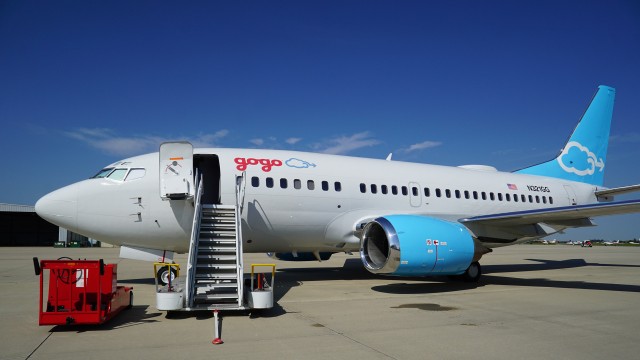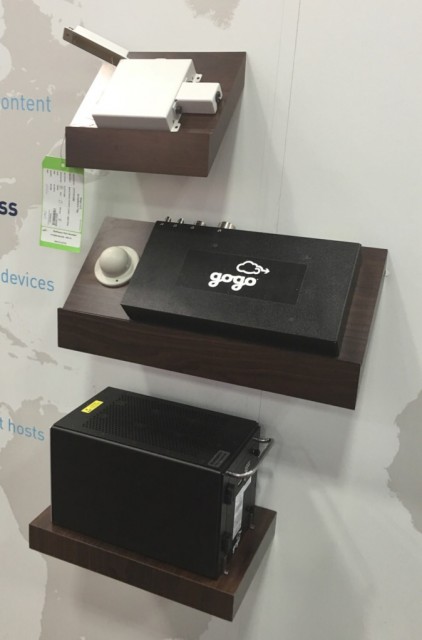
Southwest Airlines’ BYOD IFE is powered by the bump magnified above (A B738 at HNL following the airline’s first Hawaii validation flight in early 2019). – Photo: SWA Media. Edits: JL Johnson
We last looked at the Southwest Airlines BYOD in-flight entertainment (IFE) package back in 2014. At the time, the offering deserved every bit of praise given. But over the past nearly six years, the IFE space has changed a great deal. As a continued frequent Southwest Airlines flyer, when I use their IFE (and in-flight connectivity, IFC) I can’t help but cringe knowing my old review is still out there. Alas, my 2014 piece did not age well, on many fronts.
So let’s set the record straight: How have Southwest’s offerings withstood the test of time?

N321GG – Gogo’s 737-500 testbed – Photo: Gogo
Like most business travelers, I have grown accustomed to looking for the familiar WiFi symbol while boarding a plane. Just a few years ago, in-flight connectivity was a luxury and something one could not depend on, whether through spotty deployment across fleets, or because the cutting-edge technology delivering said connectivity wasn’t terribly reliable.
Over the years, however, following increased adoption among carriers, this luxury has morphed into something closer to a necessity. Business travelers like consistency, yet as comedian Louis CK accurately pointed out in one of his more popular skits amongst AvGeeks, we are more entitled than we should be. While I have grown increasingly dependent on connectivity, the underlying technology has always been a bit of a black box to me. You’ll be happy to know the hardware is in-fact encased in black boxes.

Some of the hardware required to power Gogo’s IFC and IFE systems – Photo: JL Johnson | AirlineReporter
I recently had the opportunity to catch up with the Gogo team at the Airline Passenger Experience Association (APEX) Expo in Portland to learn all about in-flight connectivity. For two days I mingled with PR folks, engineers, and even some of Gogo’s competitors in an attempt to get a solid understanding of IFC basics. Now that I have had a few days to digest the the technology and various initialisms, I’m excited to share what I learned.

Southwest 737-700 (N711HK) seen at Dallas Love Field with Row 44 raydome between the strobe and vertical stabilizer. It also sports a retro-livery design.
On November 20, 2013 Southwest Airlines announced that, effective immediately, customers could use their portable electronic devices (PEDs) gate-to-gate. This was expected as other airlines had been making similar announcements earlier in the month after the FAA relaxed their rules. What wasn’t expected was that in-flight entertainment (IFE), through their Row 44 WiFi, would also be available gate-to-gate, making them the first U.S. airline to offer a seamless integrated experience, regardless of altitude.
Southwest Airlines has long been a renegade, going against the grain, often being successful with that strategy. When the industry zigs, they zag and usually find themselves with a competitive advantage. And that’s exactly what they did when they bucked the trend of U.S. airlines signing on with traditional passenger-level-hardware IFE. Instead, Southwest chose Row 44, an industry underdog to provide their connectivity. Row 44’s network is powered solely by satellite, whereas (at the time) the other big domestic players (i.e. GoGo) focused on terrestrial (land-based cell tower) service.
BONUS: GoGo Unveils New In-Flight Technology
I’m a known critic of IFE at the airline-provided-hardware level. I am of the school of thought that if you can give me WiFi, I’ll find a way to entertain myself, with my own device(s). BYOD (that is, “bring your own device”) is gaining in popularity across many industries and applications, so why not with airlines? Traditional IFE is expensive to implement, heavy to fly around, and requires added maintenance. With passengers likely to bring the added weight of their own devices anyway, why not simply eliminate the cost and complexity?
Southwest’s in-flight connectivity is nothing new, but has matured well beyond basic WiFi. I recently had the opportunity to try out the new gate-to-gate, or in my case, gate-to-gate-to-gate Row 44 on a business trip from Kansas City with a stopover at Dallas Love Field on my way to San Antonio. Let me say, I was impressed.



